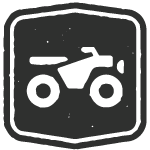
Dirt Biking


Minimize your impact by traveling only in areas open to four-wheel drive vehicles. Learn more about our RIDE ON campaign.
TRAVEL RESPONSIBLY
on designated roads and trails or in permitted areas.
Switchbacks are designed to maintain the stability of a trail. Cutting them destroys their integrity.
Travel only in areas open to dirt biking.
- On slick trails, moderate the throttle and use the clutch to gain maximum traction with minimum tailspin.
- On switchbacks, avoid roosting around the apex of the turn when climbing or brake-sliding during descent, both of which gouge the trail.
- Drive over, not around, obstacles to avoid widening the trail.
- Cross streams only at designated fording points or where the trail crosses the stream.
- Comply with all signs and barriers.
- Buddy up with two or three riders. Riding solo can leave you vulnerable if you have an accident or breakdown. Designate meeting areas in case of separation.
RESPECT THE RIGHTS OF OTHERS
including private property owners and all recreational trail users, campers and others to allow them to enjoy their recreational activities undisturbed.
- Be considerate of others on the road or trail.
- Leave gates as you find them.
- If crossing private property, be sure to ask permission from the landowner(s).
- Yield the right of way to those passing you or traveling uphill. Yield to mountain bikers, hikers and horses.
- Do not idly ride around in camping, picnicking, trailhead and residential areas.
- Keep speeds low around crowds and in camping areas.
- Keep the noise and dust down.
Obtain a map of your destination and determine which areas are open to dirt bikes.
EDUCATE YOURSELF
by obtaining travel maps and regulations from public agencies, planning for your trip, taking recreation skills classes and knowing how to use and operate your equipment safely.
- Obtain a map of your destination and determine which areas are open to dirt bikes.
- Make a realistic plan and stick to it. Always tell someone of your travel plans.
- Contact the land manager for area restrictions, closures and permit requirements.
- Check the weather forecast before you go.
- Prepare for the unexpected by packing a small backpack full of emergency items.
- Wear a helmet, eye protection and other safety gear.
- Buddy up with two or three riders. Riding solo can leave you vulnerable if you have an accident or breakdown. Designate meeting areas in case of separation.
- A DirtBike School SM class provides a fast-paced, half-day, hands-on training session. Call 1-877- 288-7093 to enroll.
- Know your state’s laws with regard to age restrictions, sound levels, vehicle registration, etc. View laws by state thanks to the American Motorcyclist Association.
- Make sure your vehicle is mechanically up to task. Be prepared with tools, supplies, spares and a spill kit for trailside repairs. (How to Clean Up Toxic Spills on the Trail)
AVOID SENSITIVE AREAS
such as meadows, lakeshores, wetlands and streams, unless on designated routes.
- Other sensitive habitats to avoid, unless on designated routes, include cryptobiotic soils of the desert, tundra and seasonal nesting or breeding areas.
- Avoid disturbing historical, archeological and paleontological sites.
- Avoid “spooking” livestock and wildlife you encounter and keep your distance.
- Motorized and mechanized vehicles are not allowed in areas designated as Wilderness. (What are Wilderness Areas?)
Avoid spreading invasive species by washing your vehicle after every ride.
DO YOUR PART
by leaving the area better than you found it, properly disposing of waste, minimizing the use of fire, avoiding the spread of invasive species, restoring degraded areas and joining a local enthusiast organization.
- Carry a trash bag on your vehicle and pick up litter left by others.
- Pack out what you pack in.
- Practice minimum impact camping by using established sites and camping 200 feet from water resources and trails.
- Observe proper sanitary waste disposal or pack your waste out.
- Protect the soundscape by preventing unnecessary noise created by a poorly tuned vehicle or revving your engine without need.
- Following a ride, wash your dirt bike and support vehicle to reduce the spread of invasive species. Learn more about invasive species.
- Don’t mix riding with alcohol or drugs.














